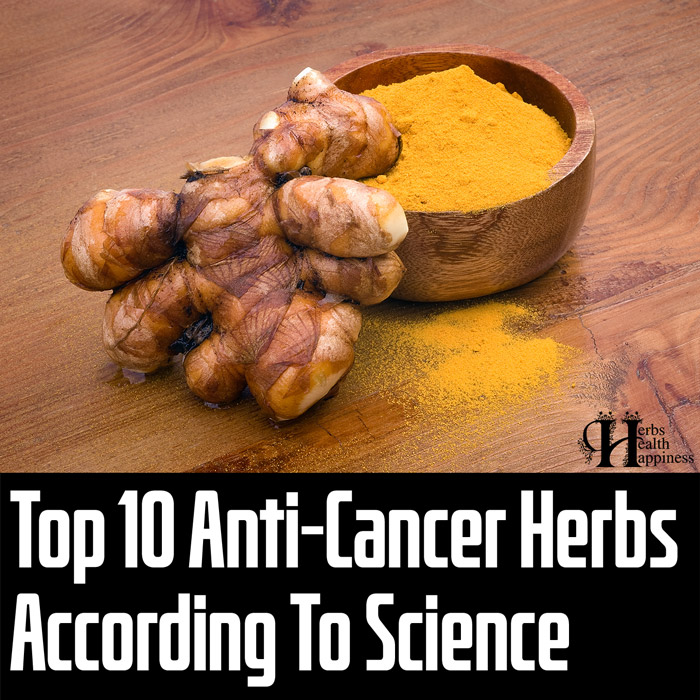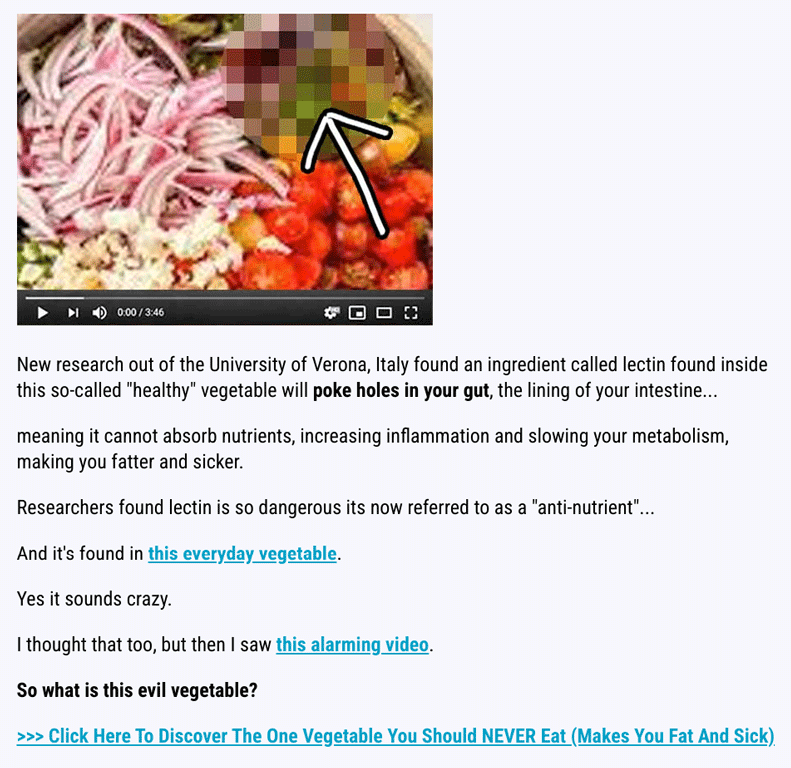
10 Of The Best Anti-Cancer Herbs According To Science Graphic © herbshealthhappiness.com Photo © AdobeStock 61315781 (under license)
Anticancer Herbs: The Top 10
We’ve combed through a mountain of scientific research to compile our Top 10 list of anti-cancer herbs! Here they are (in no particular order), together with our notes and study references:
1. Turmeric Curcuma longa or Curcuma zedoaria
Native to the Indian subcontinent and Southeast Asia, turmeric has been used – since 1900 BC – by Ayurvedic physicians to alleviate the symptoms of allergies and inflammation, liver complications, and rheumatism. [1] As a medicine, turmeric is traditionally taken as a tea or as an ingredient in chai, a traditional Indian preparation of black tea.
The component in turmeric with anticancer potential – curcumin – has been researched in depth. In scientific studies, turmeric has been posited to be effective in preventing colon and pancreatic cancers. [1]
According to an in vivo study in 2001, the rodent specimens that were given curcumin as a dietary supplement throughout their life cycle showed a significant reduction in potentially cancerous cellular activity as compared to those in the control group. [1] When administered orally to rats, curcumin was found to be effective in preventing cancer of the skin, stomach, colon, lung, and breast. [1] Recently, curcumin was determined to be a regulator of genes involved in cancer formation – in clinical trials, it was found to inhibit the migration of lung cancer cells. [1]
The idea that curcumin might inhibit cancer cell growth has prompted the formation of subsequent hypotheses. Most recently, curcumin has been studied for its potential to treat myeloma and breast cancer. [1]
It is reported that curcumin induces apoptosis (cell death) of cancer cells without cytotoxic effects on healthy cells. Curcumin achieves this via suppression of the nuclear factor-kappaB activation pathway, the activation of nuclear factor-kappaB being linked to a number of inflammatory diseases – including cancer. [2]
However while studies have been far-reaching, few conclusions have been drawn as to whether turmeric should be used as an actual cancer treatment. It does however make sense to include it as a strategic ingredient in an overall healthy diet and risk reduction plan.
Note that curcumin has somewhat low bioavailability; however this issue has been addressed significantly with the discovery that curcumin bioavailability is greatly increased by combining turmeric with black pepper in food preparations.
References:
[1] Cho William Chi-Sing (Ed.). (2011). Evidence-based Anticancer Materia Medica. https://amzn.to/3ApBbV3
[2] Aggarwal BB & Shishodia S. (2004). Suppression of the nuclear factor-kappaB activation pathway by spice-derived phytochemicals: reasoning for seasoning. https://pubmed.ncbi.nlm.nih.gov/15659827/
2. Milk thistle (Silybum marianum)
In different parts of the world, milk thistle (Silybum marianum) is used as an herbal supplement to manage problems with the liver, gallbladder, and kidneys. There have also been numerous studies focused on the potential cancer-fighting properties of the flavonoid silymarin, which is abundant in milk thistle.
Studies have found that silymarin protects against both UV-induced skin cancer and “photo aging” (light degradation) of skin. Two studies published in 2012 and 2014 have demonstrated how silibinin – the main active ingredient in milk thistle’s silymarin – is able to fight against both ultraviolet A (UVA) and ultraviolet B (UVB)-induced skin damage and cancer. The study published 2012 by Narayanapillai, et. al. concluded that silibinin could remove UVA-damaged cells from the body and help prevent skin cancer. The same results were mirrored in the 2014 study by the same researchers, this time on UVB-damaged cells. Not only was silibinin able to remove UV-damaged cells, it was also able to speed up the repair the damage on other cells. [1][2]
What’s truly astonishing is that silibinin has been found to act selectively – killing cells that have been mutated by UVA, while simultaneously being non-toxic to healthy cells and also accelerating repair of UVB-damaged non-cancerous cells. This suggests that milk thistle can play a very important role in chemotherapy, where the big problem has always been how chemotherapy drugs kill both healthy cells and cancer cells. Joaquim Bosch-Barrera, an oncologist and biomedical researcher working in Girona, Spain, has published a series of studies on milk thistle and various cancers, with some very promising results. One 2016 human study from his cancer research team found that silibinin from milk thistle significantly suppressed progressive brain metastases in lung cancer patients. [3]
For the above reasons, milk thistle appears to be one of the best of the “anti cancer herbs”. Because milk thistle is widely regarded as an excellent herbal remedy, it is readily available as a supplement in capsule or tincture form. It is considered one of the “tonic herbs” – and lab tests have reported it not to cause harm when taken over a prolonged period. [4] You can opt to take the tincture after meals or go for the capsule, which is by far the easiest way to include milk thistle in your diet.
References:
[1] Narayanapillai S, Agarwal C, et al. (2012). Silibinin is a potent sensitizer of UVA radiation-induced oxidative stress and apoptosis in human keratinocyte HaCaT cells. https://www.ncbi.nlm.nih.gov/pmc/articles/PMC3925450/
[2] Narayanapillai S, Agarwal C, et al. (2014). Silibinin inhibits ultraviolet B radiation-induced DNA-damage and apoptosis by enhancing interleukin-12 expression in JB6 cells and SKH-1 hairless mouse skin. https://www.ncbi.nlm.nih.gov/pmc/articles/PMC3883799/
[3] Bosch-Barrera et al. Response of brain metastasis from lung cancer patients to an oral nutraceutical product containing silibinin (Oncotarget, 2016) https://www.ncbi.nlm.nih.gov/pmc/articles/PMC5077992/
[4] Toxicology and carcinogenesis studies of milk thistle extract (CAS No. 84604-20-6) in F344/N rats and B6C3F1 mice (Natl Toxicol Program Tech Rep Ser. 2011 Feed Studies) https://pubmed.ncbi.nlm.nih.gov/21685957/
3. Rosemary (Rosmarinus officinalis)
There have been recent studies on Rosemary that showcase potential health benefits that involve neurological health – and more recently, cancer. Researchers have found various evidence of Rosemary’s potential as an anti-cancer agent.
In the practice of medicine, chemotherapy is the current standard in treating cancer. However, chemotherapeutic drugs are not only effectively cytotoxic against cancer cells, but also cause much harm to healthy cells as well. This is why patients undergoing chemotherapy lose their hair, experience severe weakness, and lose their appetite. But recent studies have found that medicinal plants, rosemary in particular, represent a fertile ground for the development of novel anticancer agents – as some of them have been found by lab studies to act selectively against the cancer cells without attacking the healthy cells.
A 2011 review [1] published in the peer-reviewed Critical Reviews in Food Science and Nutrition summarized research done on the anticancer potential of rosemary between 1996 and 2010, concluding that rosemary extract (presumably ethanol extract; though it is not stated), together with molecular components of rosemary ursolic acid, carnosic acid, carnosol and rosmarinic acid had anticancer potential. Evidence suggests that rosemary is able to suppress tumor development of various types – including leukemia cells, melanoma and cancers of the liver, breast, colon and stomach.
A study published in 2014 in the International Journal of Oncology reported that Carnosol, an active constituent of rosemary, significantly reduced the viability of human colon cancer (HCT116) cells, causing apoptosis or cell death through the inhibition of the signaling pathway used by the cancer cells. [2]
A 2012 study discovered that Rosemary essential oil at a concentration of 1% showed very strong anticancer activity (greater than 90%!) on two ovarian and one liver cancer cell lines in vitro. Interestingly, this effect was greater when using the whole essential oil, compared to three of its main components individually: 1,8-cineole (27.23%), alpha-pinene (19.43%) and beta-pinene (6.71%) – adding yet more weight to the herbalists’ philosophy of utilizing whole extracts or synergistic blends as opposed to isolated components. [3]
If you decide to include rosemary in your daily diet, you can easily do so by adding the herb to your dishes (chicken is rosemary’s most popular partner but it goes well with salmon and with garlic mushrooms). You can also make rosemary tea with dried leaves. You may also opt to include it in massage or bath oil blends, significantly diluted or course. Don’t ingest rosemary in essential oil form.
References:
[1] Ngo SN, Williams DB, & Head RJ. (2011). Rosemary and cancer prevention: preclinical perspectives. https://pubmed.ncbi.nlm.nih.gov/21955093/
[2] Park KW, Kundu J, et al. (2014). Carnosol induces apoptosis through generation of ROS and inactivation of STAT3 signaling in human colon cancer HCT116 cells. https://pubmed.ncbi.nlm.nih.gov/24481553/
[3] Wang W, Li N, et al. (2012). Antibacterial Activity and Anticancer Activity of Rosmarinus officinalis L. Essential Oil Compared to That of Its Main Components. https://www.mdpi.com/1420-3049/17/3/2704
4. Frankincense (Boswellia spp.) and Myrrh (Commiphora spp.)
Essential oils from frankincense and myrrh are typically found as aromatic ingredients used in incense and in skin care products like soaps and lotions. However science has found that genuine essential oils from frankincense and myrrh have the ability to suppress multiple cancers.
Through a process called hydrodistillation, essential oils from the two resins were studied by Chen, et. al. in 2013. The researchers discovered how cancer cells were susceptible to the apoptotic effects of the oils, more so with myrrh than frankincense. [1] In this study in vitro study, the essential oils from both frankincense and myrrh were shown to protect humans from breast cancer, lung cancer, cervical cancer, liver cancer and skin cancer – reducing cancer risk by at least 50% at surprisingly low concentrations. Myrrh was seen to be more effective at cancer prevention than frankincense, but both were able to significantly affect the growth of cancer cells.
A 2009 comparative study [2] focused on 374 herbal extracts and their effects on neuroblastoma and found that frankincense and myrrh ranked in the best 15 of all 374 extracts! They easily outperformed green tea, oregano, garlic, sage, ginger, rosemary, olive leaf and many others.
Earlier research published in 2006 by Akihisa, et. al. found cytotoxic effects of frankincense-derived compounds against neuroblastoma – with 15 of the 18 compounds demonstrating potent cytotoxic activities in vitro. [3] In 2011, a study on frankincense oil found that it was selective towards breast cancer cells while sparing healthy cells. [4]
If you want to give natural support against breast cancer (or other cancers specifically), you can use essential oils (appropriately diluted) from frankincense and myrrh as a massage oil. Some opt to add one or two drops of the oils to 8oz of drinking water or tea, with a little honey, as a warm drink in the morning or before bed. Be absolutely sure to use 100% pure essential oil from a reputable company and be aware that cheaper brands are often adulterated. Do not overuse.
References:
[1] Chen Y, Zhou C, et al. (2013). Composition and potential anticancer activities of essential oils obtained from myrrh and frankincense. https://www.ncbi.nlm.nih.gov/pmc/articles/PMC3796379/
[2] Mazzio EA & Soliman KF. (2009). In vitro screening for the tumoricidal properties of international medicinal herbs. https://www.ncbi.nlm.nih.gov/pmc/articles/PMC2650746/
[3] Akihisa T, Tabata K, et al. (2006). Cancer chemopreventive effects and cytotoxic activities of the triterpene acids from the resin of Boswellia carteri. https://pubmed.ncbi.nlm.nih.gov/16946522/
[4] Suhail MM, Wu W, et al. (2011). Boswellia sacra essential oil induces tumor cell-specific apoptosis and suppresses tumor aggressiveness in cultured human breast cancer cells. https://www.ncbi.nlm.nih.gov/pmc/articles/PMC3258268/
5. Moringa (Moringa oleifera)
Called the “miracle tree” on account of its many virtues, Moringa is very well known in India, parts of Africa, the Philippines and several other countries, yet it is relatively unknown in countries such as the USA. Moringa supplements are starting to become popular for their various health benefits, from treating anemia to arthritis – but while there are some scientific studies that support these claims, the research is regarded as still insufficient for a curative claim.
However, a 2013 publication in the scientific community has found medically significant links between cancer and the intake of Moringa. Since then, other researchers have focused on the anti-cancer activity presented by the Moringa plant.
The 2013 study published by Berkovich, et. al. found that an extract from Moringa oleifera leaves using hot water inhibited pancreatic cancer cell growth and increased the cytotoxic effect of a chemotherapeutic agent (cisplatin) on pancreatic cancer cells. The researchers concluded that the extract could significantly increase the efficacy of chemotherapy in humans, or even play a role as an active agent in chemotherapy. [1]
Research focused on isolating the active components and understanding the mechanism of action have focused on the compounds of Moringa kaempferol, rhamnetin and isoquercetin. Further studies have found action of moringa against ovarian cancer, lung cancer, liver cancer and melanoma in lab tests. In 2015, Al-Asmari, et. al. found that Moringa extracts used on cancer cells significantly reduced cell survival through apoptosis (programmed cell death). The study saw a 7-fold increase in dead cancer cells after treatment with Moringa leaves and bark. [2] While Al-Asmari’s study did not find Moringa seed extracts as effective as extracts from leaf and bark, Elsayed, et. al. (also in 2015) found that seed essential oils did, in fact, have potent cytotoxic activities against cancer cells. [3]
The easiest way to include Moringa in your life is through supplements in the form of capsules. They are typically taken once or twice a day with meals. Of course, you can also go natural! If you can find fresh Moringa brewing the leaves and bark for tea is a great option. In certain parts of the world, Moringa is also an important food source (which can help fight malnutrition!). The leaves can be steamed or stir-fried, or even dried and powdered so you can store the plant for future use.
References:
[1] Berkovich L, Earon G, et al. (2013). Moringa Oleifera aqueous leaf extract down-regulates nuclear factor-kappaB and increases cytotoxic effect of chemotherapy in pancreatic cancer cells. https://www.ncbi.nlm.nih.gov/pmc/articles/PMC3765468/
[2] Al-Asmari AK, Albalawi SM, et al. (2015). Moringa oleifera as an Anti-Cancer Agent against Breast and Colorectal Cancer Cell Lines. https://www.ncbi.nlm.nih.gov/pmc/articles/PMC4545797/
[3] Elsayed EA, Sharaf-Eldin MA, Wadaan M. (2015). In vitro Evaluation of Cytotoxic Activities of Essential Oil from Moringa oleifera Seeds on HeLa, HepG2, MCF-7, CACO-2 and L929 Cell Lines. https://pubmed.ncbi.nlm.nih.gov/26107222/
6. Burdock root (Arctium lappa)
Native to Europe and northern Asia, burdock root (Arctium lappa) is described in historical herbal texts as a “blood purifier.” [1] Physicians in ancient China used burdock root to treat skin conditions, venereal diseases, respiratory infections and kidney problems. In Medieval Europe, it was used to remedy various ailments including arthritis, gout, pneumonia, and scurvy. Although scientific data is lacking overall, recent diabetes research determined that burdock root is an effective eliminator of cancer-causing toxins that accumulate in the intestinal flora from improper digestion of certain foods. [2]
Burdock root has a long history of use in traditional/herbal anticancer formulas including “Flor Essence” and “Essiac.” Burdock was one of the ingredients in the controversial Hoxsey herbal formula, which was first marketed as a cancer cure in 1919. Though now discredited by orthodox medical establishments, it had many adherents in its day. Recent studies have also shown how burdock root, or Arctium lappa, can contribute to fighting cancerous growths of cells. Predes, et. al. in 2011 found that the burdock plant had significant in vitro anti-proliferative and antioxidative activity against cancer cell samples from humans. This suggests (but does not prove) that burdock root may have potential to treat cancer in humans without the dangerous side effects of chemotherapeutic drugs. Similar results were seen in another 2011 study by Urazova, et. al., wherein l-asparagine, an extract from burdock root, was able to inhibit metastasis of cancer, specifically in malignant tumors found in subjects with lung cancer. The study found that l-asparagine (an amino acid also found in asparagus) could also be used in conjunction with chemotherapy, improving its anti-cancer activity. [3][4][5]
You can find burdock root in a variety of places – and a variety of forms. Dried burdock root can be found in tea and herbal shops, as a dried root, tea, or extract. You may also see it as an ingredient in traditional-style beverages. You can even make the tea yourself if you wish – perhaps blending with other herbs and even dried fruits or vegetables as well.
References:
[1] University of Maryland Medical Center. Burdock. (via web archive) https://web.archive.org/web/20120426222110/http://www.umm.edu/altmed/articles/burdock-000227.htm
[2] Zak V. (2009). 20,000 Secrets of Tea: The Most Effective Ways to Benefit from Nature’s Healing Herbs. https://amzn.to/3qSYN12
[3] Chamberlain J. (2008). Cancer: The Complete Recovery Guide: Everything That Everyone Should Know About Cancer And How To Recover From It. https://amzn.to/3Auh7B4
[4] Predes FS, Ruiz AL, et al. (2011). Antioxidative and in vitro antiproliferative activity of Arctium lappa root extracts. https://www.ncbi.nlm.nih.gov/pmc/articles/PMC3073957/
[5] Urazova LN, Kuznetsova TI, et al. (2011). Efficacy of natural L-asparagine in the complex therapy for malignant tumors in experimental studies. https://pubmed.ncbi.nlm.nih.gov/21716205/
7. Grape Seed Extract
Grapes are a very popular fruit that also have a long history of use in natural remedies. Historically, grapes were used to manage bleeding, inflammation, and pain from diseases of the skin, kidney, and liver.
Resveratrol is a polyphenol found in red grapes. It provides a number of anti-aging health benefits – including improvements to metabolism, cardioprotection, and cancer prevention. Recent reviews however are cautious not to recommend resveratrol as a cancer treatment, highlighting both positive and negative study results. [1]
Other studies have focused on the efficacy of grape seed extract in the management of different chronic illnesses, with plenty of research done on the management of cancer, particularly colorectal cancers.
A research team from the University of Colorado Anschutz Medical Campus, Aurora, found evidence that grape seed extract was effective against colorectal cancer. In their study, the extract from grape seed induced the death of colorectal cancer cells selectively – while ignoring the body’s healthy cells. In fact, the efficacy of grape seed extract increased as the metastatic potential of the cancer cells increased. Not only is grape seed extract selective in causing cell death only in cancer cells, it was found to be more efficient the more dangerous cancer cells become. [2]
Numerous studies have demonstrated that certain nutritive and nonnutritive phytochemicals with potential cancer-preventive or antitumor activity can be isolated from grape seeds. Of these compounds, proanthocyanidins are worthy of mention. Grape seed proanthocyanidins have been found to suppress the potential of pancreatic cancer cells to migrate or spread. Through the inhibition of the movement from epithelial to mesenchymal (deeper tissue), cancer cells could not metastasize. [3]
Proanthocyanidins have also been reported to suppress the growth of colon cancers and inhibit the process of angiogenesis (creation of new blood vessels) induced by colon cancer. [4] Proanthocyanidins extracted from grape seeds were found to induce cell death in colon cancer cells in 2007. [5] Proanthocyanidins can accumulate in high amounts in the colon because they are usually poorly absorbed along the gastrointestinal tract. [4] This is possibly beneficial because it may enable the proanthocyanidins to target and suppress cancer cell growth more efficiently in the colon.
Red grapes are of course available worldwide; Grape seed extract may be found in supplement form.
References:
[1] Resveratrol and cancer: focus on in vivo evidence (Endocr Relat Cancer. 2014 ) https://www.ncbi.nlm.nih.gov/pmc/articles/PMC4013237/
[2] Derry M, Raina K, et al. (2012). Differential effects of grape seed extract against human colorectal cancer cell lines: The intricate role of death receptors and mitochondria. https://www.ncbi.nlm.nih.gov/pmc/articles/PMC3622127/
[3] Prasad R & Katiyar SK. (2012). Grape seed proanthocyanidins inhibit migration potential of pancreatic cancer cells by promoting mesenchymal-to-epithelial transition and targeting NF-κB. https://pubmed.ncbi.nlm.nih.gov/22902508/
[4] Huang S, Yang N, et al. (2012). Grape seed proanthocyanidins inhibit colon cancer-induced angiogenesis through suppressing the expression of VEGF and Ang1. https://pubmed.ncbi.nlm.nih.gov/23026853/
[5] Engelbrecht AM, Mattheyse M, et al. (2007). Proanthocyanidin from grape seeds inactivates the PI3-kinase/PKB pathway and induces apoptosis in a colon cancer cell line. https://pubmed.ncbi.nlm.nih.gov/17923279/
8. Wormwood (Artemisia absinthium)
The genus of plants called Artemisia contains several hundred species, notably including the plants mugwort, tarragon and wormwood. Wormwood (Artemisia absinthium) has been used in herbal medicine since ancient times. It has an extremely bitter taste, is highly astringent and derives its common name from its traditional use against intestinal parasites.
The most famous (or infamous) application for wormwood has been in the Absinthe alcoholic beverage. Absinthe is a strongly intoxicating alcoholic drink. Like other alcoholic drinks it can harm your liver when consumed in quantity, however absinthe was also the subject of curious and somewhat persistent superstition; with some believing (perhaps due to the Biblical mention of wormwood) that it had strange occult powers – a factor that was possibly influential in the fact it was prohibited at various times. According to old reports, absinthe was traditionally prepared using not only wormwood but a number of other herbs, including dittany of Crete, angelica, marjoram, hyssop, fennel, anise, mint and lemon balm. [1]
Wormwood has shown great promise as a potential anticancer agent – with numerous, recently-published studies focusing on how extracts from wormwood are able to target cancer cells and halt their growth. Artemisinin, a compound derived from Wormwood, has shown much promise in anti-proliferative and apoptotic (killing) effects on a number of cancer cell types. Artemisia annua was first noted as a possible anticancer herb in 2001, when two researchers at the University of Washington learned that wormwood showed highly selective activity against breast cancer cells. [2]
A mechanism of action has been proposed: It has been discovered that artemisinin reacts with iron to form free radicals that kill cells. Since cancer cells uptake relatively large amounts of iron compared to normal cells, they are more susceptible to the toxic effect of artemisinin.” [3] This demonstrates the selectivity and the anticancer effect of artemisinin is thus much enhanced (up to 100x) by the preloading of cancer cells with iron. [4]
Research conducted at the Cancer Research Laboratory, University of California (Berkeley) has found that Artemisinin was able to arrest the growth of breast cancer cells in both early and late stages of cancer, while healthy cells were spared from the plant’s cytotoxic effects. [5] Yuan, et. al. in 2016 found that flavonoids from Artemisia exhibited strong cytotoxic effects against cancer cells of the liver and the cervix. [6] According to Tilaoui, et. al. in 2015, Artemisia essential oil also has anti-proliferative effects on cancer cells. [7]
You may be able to obtain wormwood as a dried herb from a herbalist, but it’s unlikely you would want to consume it owing to its extreme bitter taste. Wormwood is also obtainable in the form of wormwood bitters, a traditional ingredient added in very small amounts to various beverages. Not only is wormwood extremely bitter tasting, but contains thujone, a convulsant when consumed in significant quantities. Self-diagnosis and self-treatment is of course not recommended; guidance from a trained professional herbalist is suggested.
References:
[1] Crowley A. The Green Goddess. (1915). http://www.museeabsinthe.com/Crowley-Green-Goddess.pdf (via web archive)
[2] Willoughby Sr. J, Sundar S, et al. Artemisinin Blocks Prostate Cancer Growth and Cell Cycle Progression by Disrupting Sp1 Interactions with the Cyclin-dependent Kinase-4 (CDK4) Promoter and Inhibiting CDK4 Gene Expression. (2009). http://www.ncbi.nlm.nih.gov/pmc/articles/PMC2629082/
[3] Lai H, Sasaki T, et al. (2004). Effects of artemisinin-tagged holotransferrin on cancer cells. http://assasmus.s.a.f.unblog.fr/files/2010/05/publicationartemisiadrlai.pdf
[4] Crespo-Ortiz M & Wei M. (2012). Antitumor Activity of Artemisinin and Its Derivatives: From a Well-Known Antimalarial Agent to a Potential Anticancer Drug. https://www.ncbi.nlm.nih.gov/pmc/articles/PMC3228295/
[5] Tin AS, Sundar SN, et al. (2012). Antiproliferative effects of artemisinin on human breast cancer cells requires the downregulated expression of the E2F1 transcription factor and loss of E2F1-target cell cycle genes. http://europepmc.org/abstract/MED/22185819
[6] Yuan H, Lu X, et al. (2016). Flavonoids from Artemisia sacrorum Ledeb. and their cytotoxic activities against human cancer cell lines. https://www.ncbi.nlm.nih.gov/pmc/articles/PMC4998194/
[7] Tilaoui M, Ait Mouse H, et al. (2015). Comparative Phytochemical Analysis of Essential Oils from Different Biological Parts of Artemisia herba alba and Their Cytotoxic Effect on Cancer Cells. https://www.ncbi.nlm.nih.gov/pmc/articles/PMC4510584/
9. Dandelion (Taraxacum spp.)
Dandelion (Taraxacum officinale) and various other dandelion species, notably in Asia (where they have been used in traditional remedies since old times), have been found to have promising anticancer action on diverse cancer types by various lab research.
A study from 2008 on aqueous extracts from the roots, leaves and flowers of dandelion plants investigated their effects on tumor progression. Dandelion root and leaf extracts were found effective against breast cancer cells and the leaf extract also inhibited the movement of prostate cancer cells. [1]
Numerous more recent cell-based studies have continued the research into various dandelion species. A compound “Taraxerol” isolated from T. mongolicum, a Chinese variety of the plant which is used in Traditional Chinese Medicine, has been the subject of extensive lab study. [2]
While positive lab studies on cell cultures are in abundance, evidence of actual anti-cancer ability of dandelion and its components in human settings appears thin on the ground. Dandelion, though considered by many a weed, is edible and nutritious, with the leaves being used in salads and the root being found in supplement and tea form. Dandelion is also a noted diuretic and may also have benefits for liver health. So in conclusion it can be considered as an edible component of a general anticancer diet, with more research being needed in order to ascertain its therapeutic value.
Other dandelion species with reported anticancer activity include Taraxacum platycarpum Dahlst. (Korean dandelion) [3], Taraxacum mongolicum [4] and Taraxacum formosanum Kitam. [5]
References:
[1] Sigstedt SC, Hooten CJ, et al. (2008). Evaluation of aqueous extracts of Taraxacum officinale on growth and invasion of breast and prostate cancer cells. https://pubmed.ncbi.nlm.nih.gov/18425335/
[2] Research on the mechanisms of taraxerol for the treatment of gastric cancer effect based on network pharmacology. Int J Immunopathol Pharmacol. (2022) https://www.ncbi.nlm.nih.gov/pmc/articles/PMC8743941/
[3] Polysaccharide extracted from Taraxacum platycarpum root exerts immunomodulatory activity via MAPK and NF-κB pathways in RAW264.7 cells. J Ethnopharmacol. (2021) https://pubmed.ncbi.nlm.nih.gov/34390795/
[4] Total flavonoids of Taraxacum mongolicum inhibit non-small cell lung cancer by regulating immune function. J Ethnopharmacol. (2021) https://pubmed.ncbi.nlm.nih.gov/34384846/
[5] Antioxidant property of Taraxacum formosanum Kitam and its antitumor activity in non-small-cell lung cancer cells. Phytomedicine. (2018) https://pubmed.ncbi.nlm.nih.gov/30217255/
10. “Medicinal Mushrooms”
Mushrooms have a wide range of uses – from culinary to medicinal. They have been found to contain a wealth of bioactive compounds that exert cancer-preventive effects, which have potential as novel anticancer agents. These compounds found in mushrooms have a variety of biological activities, including immunomodulating, free radical-scavenging, anti-inflammatory, antibacterial, antifungal, antiviral, hepatoprotective, antidiabetic, and anticancer properties. It comes without surprise that medicinal mushrooms have always played an integral role in traditional Chinese medicine (TCM) for preventing or treatment of a variety of diseases, including cancer. [1]
A study from the Cancer Research Laboratory of the Methodist Research Institute, Indianapolis, demonstrated the therapeutic potential of medicinal mushrooms against breast cancer cells. According to this study, published by Jiang and Sliva in 2010, medicinal mushrooms retard the proliferation of highly invasive breast cancer cells by inducing cell cycle arrest and inhibiting the expression of genes that regulate the cell cycle of cancer cells. The ability of breast cancer cells to adhere, migrate, and invade was also suppressed by the medicinal mushroom blend – effectively stopping metastasis. [2]
Patel and Goyal in 2012 published an updated review on anti-tumor mushrooms. Mushrooms belonging to the following genera have been found to have anticancer potential: Ganoderma, Flammulina, Trametes, Cordyceps, Agaricus, Suillus, Lactarius, Clitocybe, Albatrellus, Phellinus, Inonotus Antrodia, Pleurotus, Calvatia, Schizophyllum, Fomes, Funlia, Inocybe, Russula, and Xerocomus.
The researchers conclude that mushrooms have a big potential in stopping the cancer cell cycle at different stages, and could potentially be used in forms of cancer that lack effective chemotherapeutic drugs such as lymphocytic leukemia, acute myeloid leukemia, and Hodgkin’s lymphoma. [3]
Numerous scientific studies (mostly from Asia) have investigated the anticancer properties of Reishi Mushroom (Ganoderma lucidum). The Reishi mushroom is a focus of recent studies on cancer, with a recent publication in 2016 by Jin, et. al. The researchers found that the mushroom could be used adjunct to conventional chemotherapy, by improving tumor response to treatment and boosting the immune system. [4]
Trametes versicolor (Turkey Tail Fungus) is another regarded to have significant anticancer potential, with celebrated mycologist Paul Stamets singing its praises after it was included in a successful cancer protocol that saved the life of a family member.
Most of the fungi listed above are not in the culinary sphere but are typically seen in either supplement (capsule) or ethanol extract forms, which have grown in popularity in recent years.
Remember to be safe; only harvest mushrooms if you have had the correct training to identify the species accurately.
References:
[1] Petrova RD. (2012). New scientific approaches to cancer treatment: can medicinal mushrooms defeat the curse of the century? https://pubmed.ncbi.nlm.nih.gov/22339703/
[2] Jiang J & Sliva D. (2010). Novel medicinal mushroom blend suppresses growth and invasiveness of human breast cancer cells. https://pubmed.ncbi.nlm.nih.gov/21042722/
[3] Patel S & Goyal A. (2012). Recent developments in mushrooms as anti-cancer therapeutics: a review. http://www.ncbi.nlm.nih.gov/pmc/articles/PMC3339609/
[4] Jin X, Ruiz Beguerie J, et al. (2016). Ganoderma lucidum (Reishi mushroom) for cancer treatment. https://www.ncbi.nlm.nih.gov/pmc/articles/PMC6353236/
★ Get My Books - 100% FREE:
😳 Tinnitus And Brain Health?
After 47 years of studies and countless brain scans done on more than 2,400 tinnitus patients, scientists at the MIT Institute found that in a shocking 96% of cases, tinnitus was actually shrinking their brain cells.
As it turns out, tinnitus and brain health are strongly linked.
Even more interesting: The reason why top army officials are not deaf after decades of hearing machine guns, bombs going off and helicopter noises…
Is because they are using something called "the wire method", a simple protocol inspired by a classified surgery on deaf people from the 1950s...
★ How To Get Rid Of Nail Fungus:
★ Does Your Salad Contain This Vegetable?
★ 20 Natural Painkillers In Your Kitchen (Video):
★ Men's Prostate Health:

2. Famous Chef Sheds 60lbs Researching New Paleo Recipes: Get The Cookbook FREE Here
3. #1 muscle that eliminates joint and back pain, anxiety and looking fat
4. 7 odd foods that KILL your abdominal fat (surprising fat-fighters)
5. The TRUTH about bread (Will surprise you!)
6. [PROOF] Reverse Diabetes with a "Pancreas Jumpstart"
7. Here's What Happens When You "Unlock Your Hip Flexors"
8. The #1 WORST food that CAUSES Faster Aging (beware -- Are you eating this?)
The #1 Muscle That Eliminates Joint And Back Pain, Anxiety And Looking Fat
By Mike Westerdal CPT
Can you guess which muscle in your body is the #1 muscle that eliminates joint and back pain, anxiety and looking fat?
This is especially important if you spend a significant amount of time sitting every day (I do, and this really affects me in a big way!)
Working this "hidden survival muscle" that most people are simply not training because no-one ever taught them how will boost your body shape, energy levels, immune system, sexual function, strength and athletic performance when unlocked.
If this "hidden" most powerful primal muscle is healthy, we are healthy.
Is it...
a) Abs
b) Chest
c) Glutes
d) Hip Flexors
Take the quiz above and see if you got the correct answer!
P.S. Make sure you check out this page to get to know the 10 simple moves that will bring vitality back into your life:
If you enjoyed this page:














